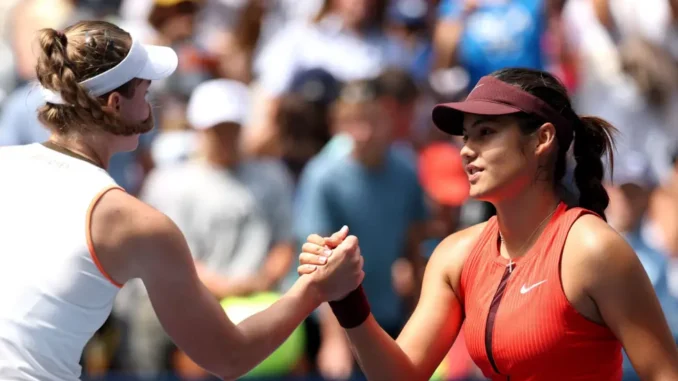
Emma Raducanu’s meteoric rise to fame in 2021, when she clinched the US Open title as an 18-year-old qualifier, remains one of the most remarkable stories in modern tennis. However, since that historic triumph, the British No. 1 has faced challenges in consistently competing with the world’s top players. Her recent third-round exit at the 2025 US Open against Elena Rybakina, a former Grand Slam champion, highlighted the gap she still needs to close. Despite the 6-1, 6-2 defeat, Raducanu remains optimistic, believing that with strategic improvements, dedicated training, and a new coaching partnership, she can challenge the sport’s elite. So, how can Raducanu elevate her game to match the likes of Rybakina, Iga Świątek, and Aryna Sabalenka?
Raducanu’s 2025 season has shown signs of resurgence. After battling injuries, including wrist and ankle surgeries that sidelined her for much of 2023, she has climbed back to the cusp of the world’s top 30. Her performances at tournaments like the Miami Open, where she reached her first WTA 1000 quarter-final, and the Mubadala Citi DC Open, where she made the semi-finals, demonstrate her potential. A thrilling match against world No. 1 Aryna Sabalenka at Wimbledon, where she pushed the top seed to a 7-6, 6-4 battle, further underscored her ability to compete at the highest level. “The positives are that I was toe to toe with her,” Raducanu reflected after the Wimbledon loss. “It gives me confidence that I’m not as far away as I perhaps thought before the tournament, but at the same time, it’s very difficult to take right now.”
One critical area for improvement is Raducanu’s serve. Against Sabalenka, whose serve reached speeds of 121 mph, Raducanu noted a “clear difference in the first serve” as a factor in her defeat. Her own serve, while strong at up to 110 mph, lacks the consistency and power of top players. Enhancing her first serve’s accuracy and adding variety, such as incorporating more spin or placement, could make it a more formidable weapon. Her second serve, delivered at 93 mph—above the WTA average—shows promise, but she needs to develop greater confidence to maintain offensive play even when her first serve falters.
Raducanu’s aggressive baseline game, anchored by her “world-class” two-handed backhand, is a strength. However, her forehand remains less reliable, often breaking down under pressure from power players like Rybakina, whose blistering pace left Raducanu struggling to respond. “I felt I was on the receiving end of that—it was hard to take, of course,” she admitted after the US Open loss. Training with players who emulate the intensity of top-tier opponents could help her adapt to high-paced shots. Suggestions have been made that practicing with male players, who often hit with greater power, could better prepare her for these encounters.
Coaching has been a revolving door for Raducanu since her US Open win, with multiple changes drawing scrutiny. Her recent partnership with Francisco Roig, a seasoned coach who guided Rafael Nadal to 22 Grand Slam titles, feels like a promising step. Roig’s technical expertise and ability to identify subtle flaws in a player’s game have already shown early results. In their first tournament together at the Cincinnati Open, Raducanu pushed Sabalenka to a three-set thriller. “It’s only been three weeks, but it’s been a pretty successful three weeks in a sense that we’ve made good improvements,” Raducanu noted. Roig’s drills, described as practical and specific, focus on improving shot quality and consistency, which Raducanu acknowledges as a priority: “The overall quality of my game needs to be better.”
Mental resilience is another key factor. Raducanu believes top players approach matches against her with extra motivation, as if they have “a point to prove.” This dynamic adds pressure, but it also highlights her status as a Grand Slam champion who commands respect. Developing mental toughness to handle these high-stakes encounters will be crucial. Her ability to “scrap” and play big points well, as she describes, is a foundation to build upon, but maintaining focus throughout matches will help her capitalize on opportunities, like the set and break points she missed against Sabalenka.
External factors, such as the heavier tennis balls used in some tournaments, have also been cited as a challenge. These balls, designed to encourage longer rallies, can exacerbate injury risks and affect Raducanu’s ability to generate pace. Adapting her game to these conditions, perhaps by focusing on agility and tactical shot placement, could mitigate their impact.
As Raducanu prepares for the Asian hard-court swing and the 2026 season, her focus remains clear: consistent improvement to challenge the elite. With Roig’s guidance, a refined serve, and enhanced physical and mental conditioning, she is on the right path. “I’ve just got to do my best in the next few months until Australia to keep working to try to close the gap,” she said. Her journey is far from over, and with her talent and determination, Raducanu is poised to once again make waves in the tennis world.
Leave a Reply